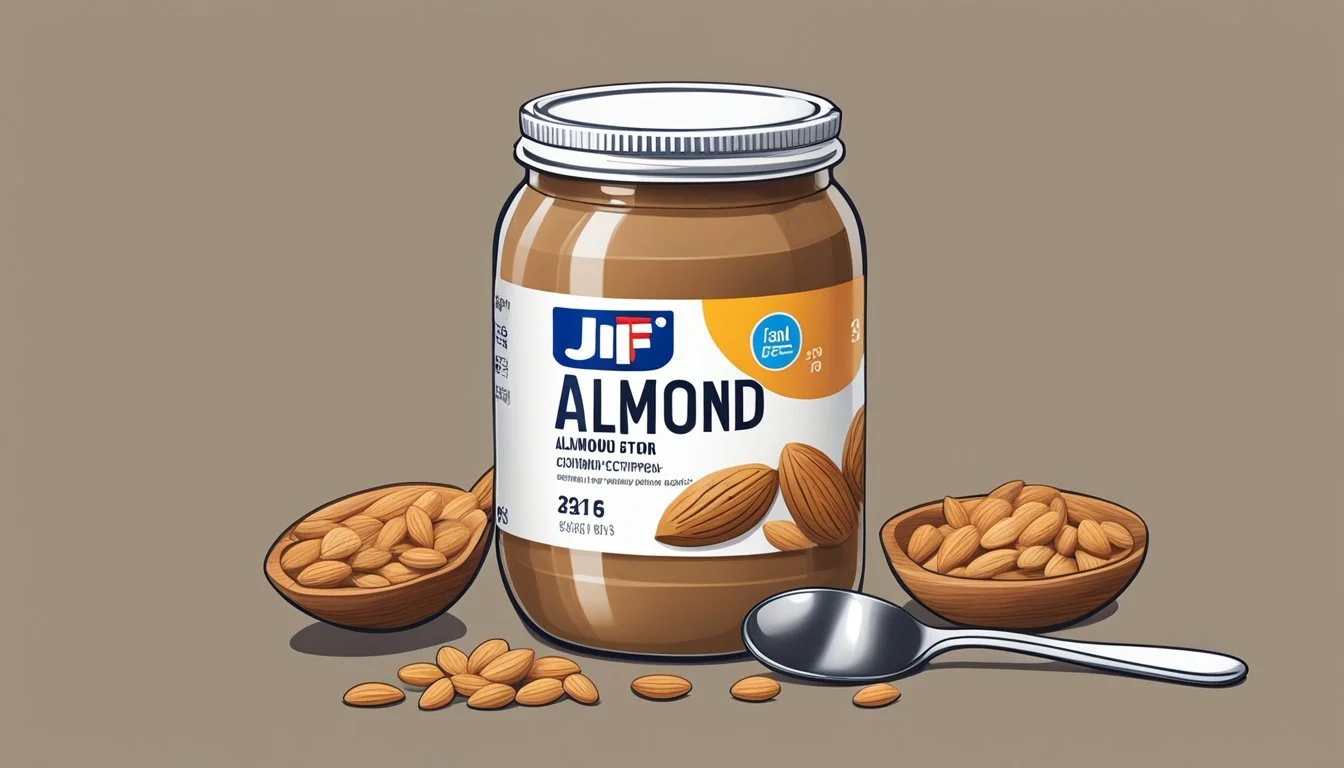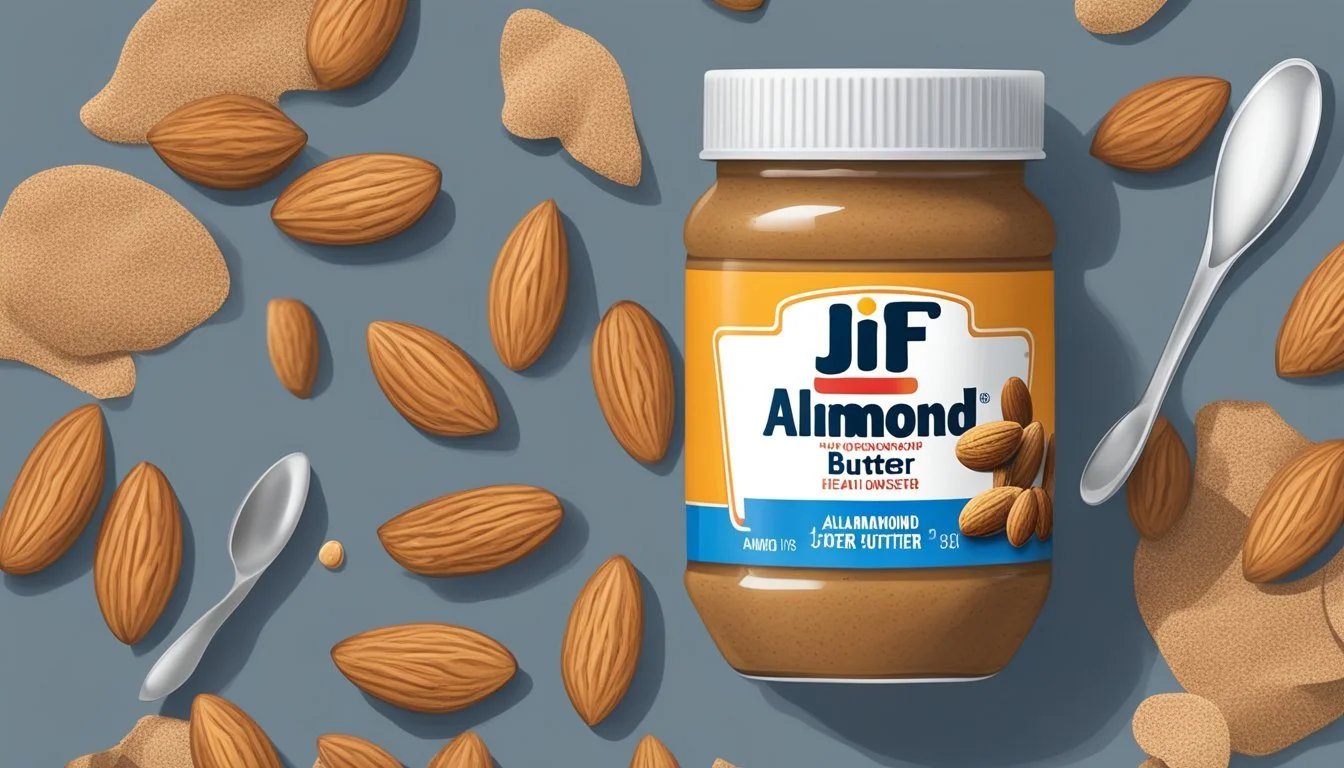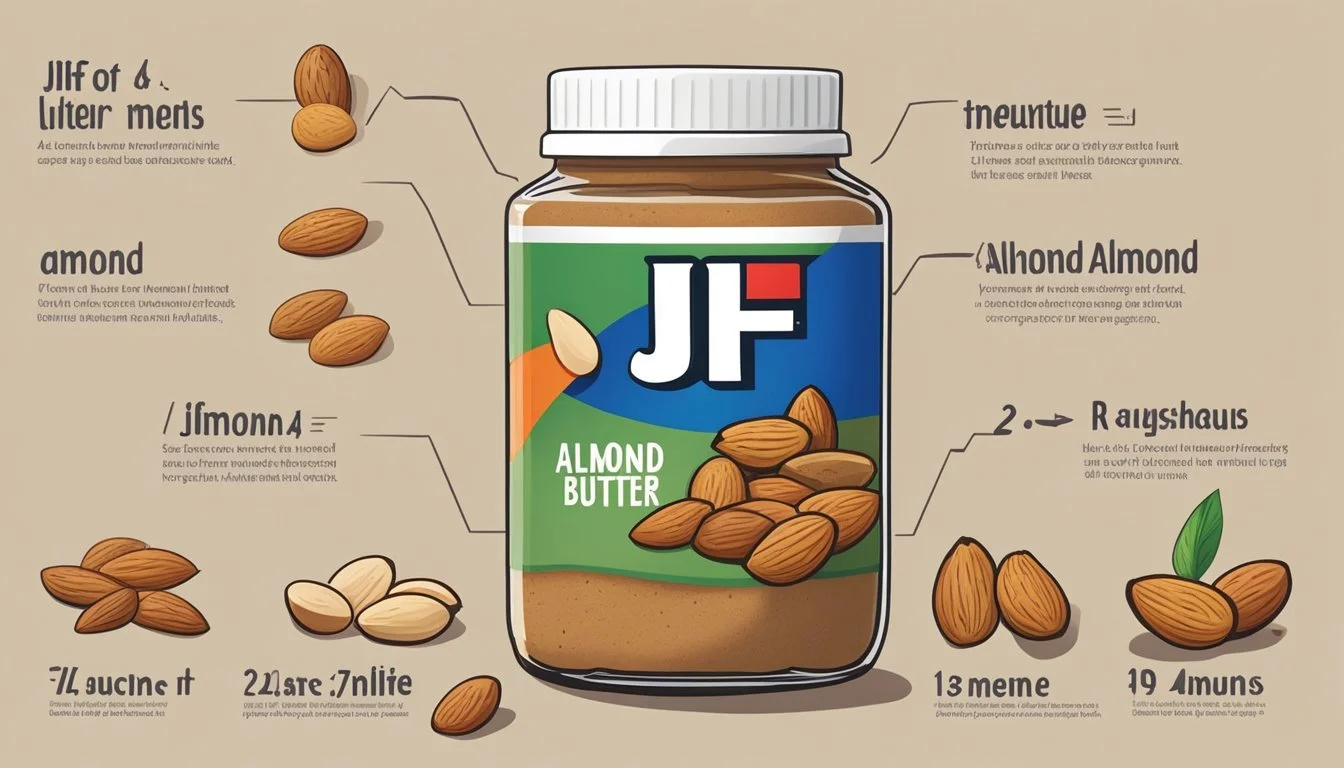How Much Jif Almond Butter Per Day Is Too Much?
Unpacking Daily Limits
Almond butter has become a staple in health-conscious diets, appreciated for its nutritional value and the richness it adds to a variety of meals. As a plant-based source of protein and healthy fats, particularly unsaturated fats, it aligns with dietary patterns that support heart health. Unlike its predecessor, peanut butter, almond butter offers a unique blend of vitamins, minerals, and antioxidants, including a substantial amount of vitamin E, which plays a crucial role in skin health and overall cellular protection.
However, as with any food high in calories and fats, the key to reaping the benefits of almond butter is moderation. A serving of Jif almond butter, or any brand for that matter, typically contains around 190 calories along with a balance of 7 grams of protein and 16 grams of fat. This dense nutritional profile means that portion control is vital to prevent excessive calorie intake, which could offset the health benefits.
Health experts suggest that one to two tablespoons of almond butter is an appropriate serving size to include in a daily diet. Consuming this recommended amount can aid in managing weight, while still allowing individuals to enjoy the protective health benefits offered by the wholesome snack. It's important to note that the ideal intake may vary based on individual dietary needs, activity levels, and overall health goals, therefore personalization is encouraged.
Nutritional Profile of Almond Butter
Almond butter provides a dense nutritional profile, rich in healthy fats, protein, and essential vitamins and minerals. Its composition makes it a valuable addition to a balanced diet, with particular benefits for heart health and cholesterol management.
Fats and Healthy Fats
Almond butter is predominantly composed of fats, accounting for approximately 71% of its caloric content. The fats present are mostly unsaturated, which are known to be heart-healthy. Specifically, almond butter contains monounsaturated and polyunsaturated fats, which can help maintain healthy cholesterol levels. In a serving of Jif Almond Butter, there are around 16 grams of fat, which contribute to its creamy texture and satiating qualities.
Protein and Fiber
A serving of almond butter also provides a modest amount of protein and fiber, essential for muscle repair and digestive health. A 2-tablespoon serving contains about 3 grams of fiber and 7 grams of protein. Fiber contributes to a feeling of fullness, potentially aiding in weight management, while protein is crucial for bodily functions and muscle health.
Vitamin and Mineral Content
Almond butter is a source of vitamins and minerals, including significant levels of Vitamin E, calcium, magnesium, and manganese. These nutrients play a role in numerous bodily processes. For instance, one tablespoon of unsalted almond butter contains 60 milligrams of calcium and is also a good source of magnesium, which together support bone health.
Comparison with Other Nut Butters
When compared to other nut butters, like peanut butter, almond butter generally has a similar calorie count but stands out for its vitamin and mineral content, particularly Vitamin E. Almond butter also tends to have higher amounts of monounsaturated fats. These differences can influence one's choice when considering overall nutritional goals and health benefits, such as those related to heart health and cholesterol management.
Health Benefits
Consuming Jif almond butter in moderation can offer numerous health benefits, including improved heart health and blood sugar regulation. It's a nutrient-dense food that contributes to overall wellness.
Cardiovascular Health
Almond butter is rich in unsaturated fats, which are beneficial for heart health. These fats can help maintain healthy cholesterol levels by lowering harmful LDL cholesterol and increasing beneficial HDL cholesterol. A serving size of almond butter also contains vitamin E, an antioxidant that supports cardiovascular health.
Weight Management
The high unsaturated fat and fiber content in almond butter can promote satiety, which may aid in weight management. Its ability to provide a feeling of fullness can reduce overall calorie intake, potentially leading to weight loss for those who are calorie-conscious.
Bone Health
Almond butter provides a decent amount of calcium and magnesium, two minerals essential for bone health. Regular intake of these minerals through almond butter can contribute to maintaining strong and healthy bones.
Blood Sugar Regulation
Thanks to the combination of healthy fats, fiber, and protein, almond butter has a low glycemic index and does not cause sharp spikes in blood sugar. This property makes it a suitable option for maintaining insulin sensitivity and supporting blood sugar control.
Anti-Inflammatory Properties
Almond butter contains omega-6 fatty acids, which have anti-inflammatory effects when consumed in balance with omega-3s. The anti-inflammatory properties of these unsaturated fats are crucial in reducing chronic inflammation and promoting overall health.
Potential Risks and Considerations
While Jif almond butter can be a nutritious addition to one's diet, it is important to be aware of potential risks and considerations associated with its consumption, particularly regarding allergies, added sugars, and oxalate content.
Allergies and Intolerances
Almond butter, including that produced by Jif, poses a risk for those with nut allergies. Almonds are a common allergen, and exposure for those with an allergy can result in severe reactions. It is also possible for individuals to develop intolerances to almonds, which, while typically less severe than allergies, can still cause discomfort and digestive issues.
Caloric and Sugar Content
One serving of Jif almond butter, approximately 2 tablespoons, contains around 190 calories and 3 to 4 grams of added sugar. Consuming it in moderation is therefore crucial; excessive intake can contribute to weight gain. Individuals monitoring their sugar intake, such as those with diabetes, should carefully consider the sugar content, particularly in flavored or sweetened varieties.
Oxalates and Kidney Stones
Almonds, and consequently almond butter, contain oxalates. High levels of oxalates can contribute to the formation of kidney stones in susceptible individuals. Those with a history of oxalate-containing kidney stones should monitor their consumption to avoid exacerbating this condition.
Daily Consumption Guidelines
When it comes to incorporating Jif almond butter into one's diet, understanding the recommended serving size and balancing nutrient intake is essential for maintaining a healthy eating pattern.
Recommended Serving Size
A typical serving size of Jif almond butter is about 1 to 2 tablespoons per day. This quantity ensures an individual can enjoy the taste and nutritional benefits of almond butter, including healthy fats, without excessive calorie intake. Specifically, one tablespoon equals approximately 95 to 100 calories, with the calorie count slightly varying based on the specific Jif almond butter product.
Balancing Nutrient Intake
It is crucial to balance one's nutrient intake when including almond butter in the diet. While almond butter offers a good source of unsaturated fats, it should be consumed in moderation within the context of a balanced diet. Jif almond butter provides essential nutrients such as:
Proteins: Necessary for tissue repair and growth
Healthy fats: Support heart health and provide sustained energy
Vitamins and Minerals: Such as Vitamin E, Magnesium, and Calcium
One should be cautious not to exceed the recommended serving size regularly as this could lead to an imbalance in daily caloric and fat intake.
Culinary Uses and Recipes
When incorporating Jif almond butter into a daily diet, chefs and home cooks alike use it in various forms ranging from baking to smoothies. Each application allows for a different expression of almond butter's rich and nutty flavor.
Almond Butter in Baking
In baking, almond butter serves as a substitute for other fats, adding a depth of flavor to baked goods, like cookies and pastries. For instance, one might use almond butter in a 1:1 ratio with fats like butter or oil in recipes to create moist and tender textures. A tip to remember: to prevent dryness in the final product, it's essential to adjust liquid ingredients accordingly.
Spreads and Smoothies
As a spreadable option, almond butter is a classic choice to slather on toast, adding protein and flavor. Similarly, adding a tablespoon of Jif almond butter to a smoothie can enrich the taste while providing a creamy consistency and an extra dose of nutrition.
Smoothie Ingredients Quantity Almond butter 1 tbsp Banana 1 Almond milk 1 cup Honey 1 tsp Ice cubes A few
Blend until smooth for a quick and nutritious snack.
Cooking and Savory Dishes
Almond butter can also be a star in savory dishes, offering a thickening agent to sauces and dressings. A dollop of almond butter can transform a basic curry, giving it a rich texture and complex taste, or form the base of a salad dressing where it balances acidity and adds creaminess.
Sauce Recipe: Mix almond butter with ingredients like soy sauce, lime juice, and chili paste for an Asian-inspired dish.
Salad Dressing: Whisk almond butter with apple cider vinegar, olive oil, and preferred seasonings for a quick emulsification.
In summary, Jif almond butter’s versatility in cooking and baking is extensive, providing a wealth of options for enhancing flavor and texture in a wide array of recipes.
Understanding Food Labels
Food labels provide essential information about the nutritional content of foods, aiding consumers in making informed choices. It's important to assess the amount of added sugars, salt, and the different varieties of almond butter to maintain a balanced diet.
Identifying Added Sugars and Salts
When examining a food label, one should pay attention to the ingredients list as product manufacturers are required to list all ingredients, including added sugars and salts. The Nutrition Facts label will disclose the total amount of sugars and sodium per serving, which includes both the naturally occurring and added amounts.
Added Sugars: These are sugars that are incorporated during processing and not naturally present in the almonds used to make almond butter. On the label, look for terms like:
Corn syrup
Dextrose
Fructose
High-fructose corn syrup
Sucrose
The label might indicate grams (g) of added sugars under the Total Carbohydrate section. Tracking this can help in ensuring intake does not exceed the recommended daily limit of added sugars, which is no more than 10% of total calories for the day.
Added Salt: Also known as sodium chloride, salt is often added to enhance flavor. High sodium intake can lead to health issues such as high blood pressure. The % Daily Value (%DV) provides guidance on how much a nutrient contributes to a daily diet based on a 2,000-calorie reference diet. A product with 5% DV of sodium or less is considered low, whereas a product with 20% DV or more of sodium is viewed as high.
Recognizing Different Varieties
Varieties of almond butter can affect the nutritional content significantly. Labels on almond butter jars can help differentiate between them. The common varieties include:
Natural Almond Butter: should list almonds as the primary ingredient, sometimes followed by a minimal amount of salt.
Processed Almond Butter: Apart from almonds, may contain added oils, sugars, and salts. It could also involve more preservatives.
To select healthier options, one should look for varieties with the least amount of added ingredients. Nutrient claims such as "low in sodium" or "no added sugars" can be helpful but should be verified in the nutrition facts. The order of the ingredients can also indicate the proportion in the product, with the main ingredient listed first.
By understanding food labels, consumers can make healthier choices and manage their intake of Jif almond butter as part of a balanced diet.
Making Your Own Almond Butter
Creating homemade almond butter allows one to enjoy a spread that is rich in healthy fats and can be customized to personal taste. The process is straightforward, requiring only a few tools and ingredients.
Homemade Process
To make almond butter, one begins by roasting almonds in the oven at 350°F for approximately 10 minutes, or until they are golden and fragrant. Stirring the almonds halfway through the roasting process ensures even cooking. Once roasted, the almonds should be allowed to cool slightly before transferring them to a food processor. The blending process may take some time; one should blend the almonds until they achieve a creamy texture, stopping to scrape down the sides of the processor as needed.
Tools and Ingredients:
High-speed blender or food processor
2 cups of raw, unpeiled almonds
Steps:
Preheat oven to 350°F.
Spread almonds in a single layer on a baking sheet.
Roast for 10 minutes, stirring halfway.
Allow to cool until just warm.
Blend in a processor until creamy, scraping sides occasionally.
Adding Flavors and Ingredients
Homemade almond butter can be personalized with a variety of flavors and ingredients. For a touch of sweetness, one might blend in honey to taste after achieving a creamy consistency. A pinch of cinnamon can also be added for warmth and depth of flavor, transforming the almond butter into a more complex spread. It's important to add these ingredients gradually and taste frequently to achieve the desired flavor profile.
Flavor Enhancers:
Honey: Start with one tablespoon and adjust to taste.
Cinnamon: Add a quarter teaspoon for a subtle hint, or more for stronger flavor.
Incorporating Almond Butter into a Balanced Diet
Incorporating almond butter into a balanced diet requires attention to portion sizes and thoughtful choices about the foods with which it is combined. A serving size of 1 to 2 tablespoons is generally recommended to take advantage of its health benefits without excessive calorie intake.
Combining with Fruits and Whole Grains
Almond butter pairs well with a variety of fruits and whole grains. For example, spreading almond butter on a slice of whole-grain toast or adding it to oatmeal can enhance satiety and provide lasting energy. Almond butter's healthy fats complement the fiber in whole grains and the vitamins in fruits like apples, forming a nutritious and satisfying meal or snack.
Breakfast: Oatmeal with a tablespoon of almond butter and sliced apples.
Snack: Whole-grain crackers with a light layer of almond butter.
Snacking in Moderation
Almond butter is calorie-dense, making moderation key when snacking. A mid-morning snack of almond butter with a piece of fruit like apple ensures a controlled intake of healthy fats and fiber, which can help manage hunger and support a balanced diet.
Responsible Snacking: 1 tablespoon of almond butter with apple slices.
Meal Planning
When planning meals, including almond butter can help meet the dietary requirement for healthy fats. One should consider the overall calorie and nutrient intake of the day to ensure almond butter enhances rather than unbalances the diet.
Meal Example: Adding a tablespoon of almond butter into a smoothie for extra protein and healthy fats.
Almond Butter in the Context of Health Conditions
Almond butter can have varying effects on different health conditions due to its nutritional composition. It is rich in monounsaturated fats, which may influence heart health, blood pressure, and diabetes management, and contains nutrients relevant to cancer prevention.
Heart Disease and Cholesterol Management
Consumption of almond butter, in controlled portions, can be beneficial for heart disease and cholesterol management. The monounsaturated fats present may help to reduce low-density lipoprotein (LDL or "bad") cholesterol levels and overall cholesterol, which are risk factors for heart disease. Additionally, almond butter is a good source of magnesium, which contributes to cardiovascular health by improving blood flow and reducing plaque buildup in the arteries.
HDL Cholesterol: Almond butter contains healthy fats that can increase high-density lipoprotein (HDL or "good") cholesterol.
Plaque Buildup: The anti-inflammatory effects of almond butter can help to reduce inflammation that leads to plaque buildup in the arteries.
Diabetes and Blood Pressure Control
The magnesium in almond butter also plays a crucial role in blood pressure control and diabetes management. Proper magnesium intake is associated with a lower risk of diabetes due to its influence on blood glucose levels and insulin sensitivity. Consistent consumption of almond butter should be measured, taking into account its calorie density.
Blood Pressure: Nutrients in almond butter can help in maintaining normal blood pressure levels.
Diabetes: Low-glycemic foods like almond butter may aid in preventing blood sugar spikes.
Cancer Prevention
Almond butter contains vitamin E, an antioxidant that helps protect cells from damage; this could be relevant in cancer prevention. Regular inclusion of almond butter in a balanced diet might play a part in reducing chronic diseases associated with cell damage and inflammation.
Cell Damage: Antioxidants in almond butter help in protecting against oxidative stress leading to cell damage.
Chronic Diseases: By reducing cell damage that leads to chronic inflammation, almond butter may indirectly reduce the risk of some chronic diseases, including certain types of cancer.
The History and Evolution of Almond Butter
Almond butter has a rich heritage tracing back to the Mediterranean, a region historically abundant with almond trees. This nutritious spread has undergone a significant evolution, deeply intertwined with cultural and nutritional trends over the centuries.
Ancient Beginnings: Almonds, and by extension almond butter, were praised for their health benefits as far back as ancient times. In various cultures, almonds have been a staple, both as a snack and as an ingredient in various dishes.
Industrial Development: The commercial production of nut butters began in the late 19th century, albeit initially with peanuts. However, it wasn't long before almonds became part of this burgeoning industry. An important reference point includes Kellogg's introduction of almond butter in the early 20th century, indicated by a 1913 mention in the Journal of the American Medical Association.
Nutritional Recognition: Almond butter is valued for its health benefits, containing vitamins, minerals, and healthy fats. It is a source of:
High potassium, beneficial for blood pressure control.
Calcium and magnesium, essential for bone health.
Fats that can improve good cholesterol levels while reducing bad cholesterol.
Modern Popularity: In recent years, the demand for almond butter has spiked, driven by its dietary advantages and the rise of food sensitivities; it's viewed as a healthier alternative to peanut butter, particularly for those with peanut allergies.
By adapting to the changing tastes and health consciousness of society, almond butter has secured its place as a versatile and nutritious food. Its journey mirrors the broader evolution of nut butters, highlighting the human quest for healthier, tastier, and more convenient food options.











